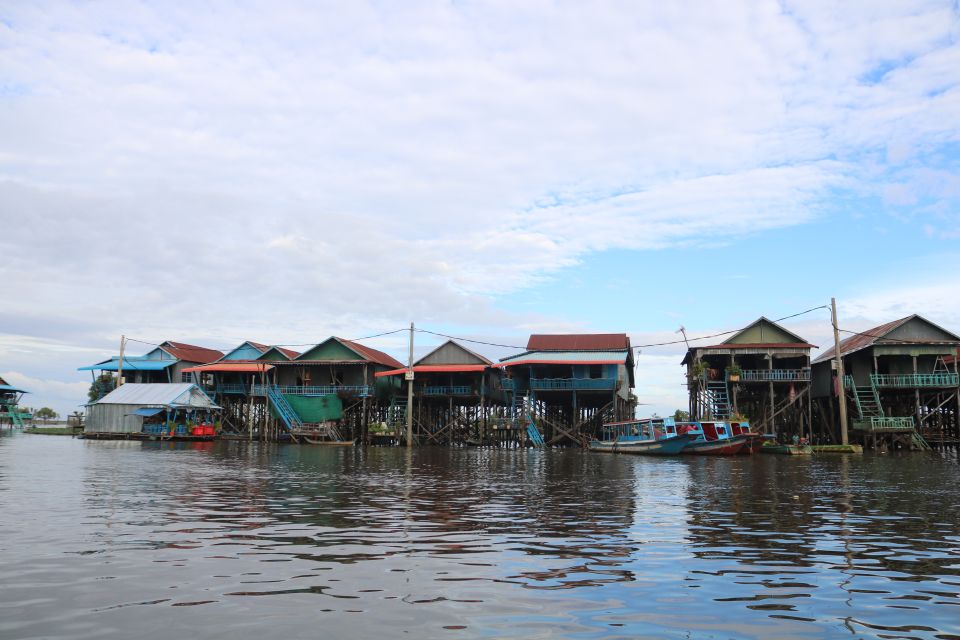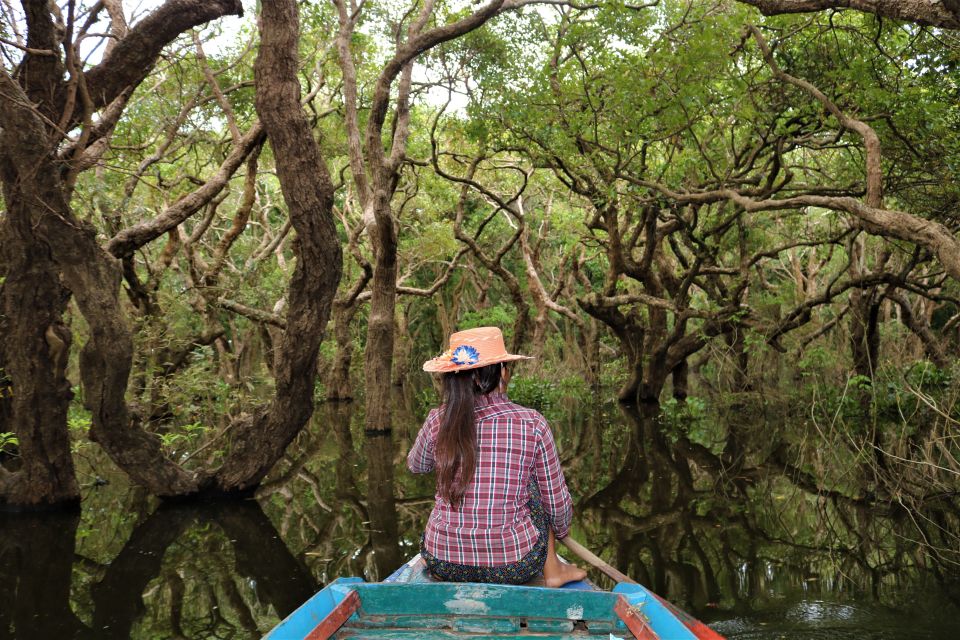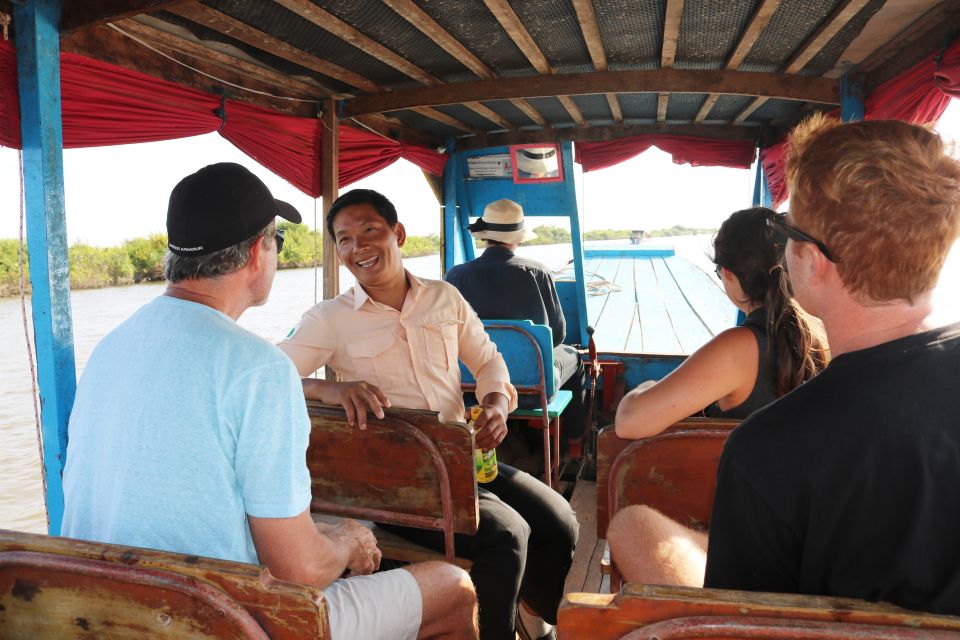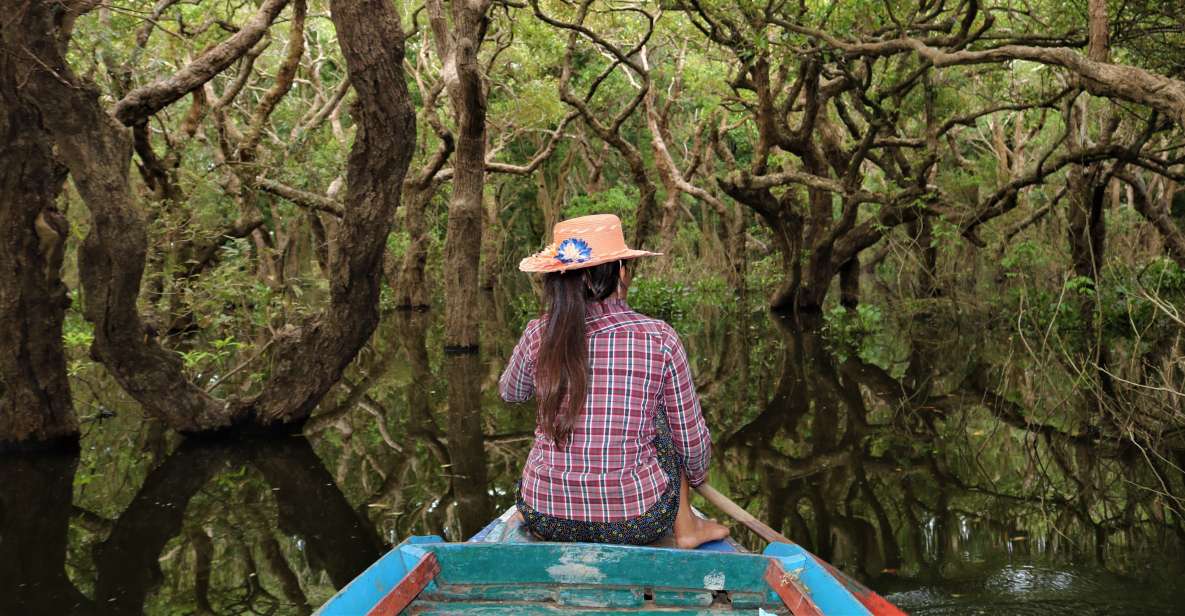Tonle Sap Lake, a UNESCO biosphere reserve in Cambodia, offers a captivating glimpse into a unique ecosystem where vibrant fishing villages like Kampong Phluk thrive. These stilted homes rise and fall with the seasons, showcasing the local community’s resilience and adaptability. The flooded forests not only support diverse wildlife but also create a rich environment for traditional fishing practices. As visitors glide through serene waterways, they encounter authentic Khmer culture and cuisine, yet the true depth of this region’s ecological and social dynamics remains to be uncovered. What secrets lie beneath the surface of this fascinating landscape?
Good To Know

- Tonle Sap Lake features vibrant fishing villages like Kampong Phluk, showcasing stilt houses adapted to seasonal water changes.
- The flooded forest ecosystem supports diverse wildlife, including nesting birds and fish, thriving during the wet season.
- Visitors can experience local culture through activities such as fish paste making and traditional rice planting in rural markets.
- Scenic boat cruises provide an opportunity to explore the lake’s unique landscapes and immerse in local heritage.
- The best visiting times are during the wet season for wildlife sightings or the dry season for calm waters and pleasant weather.
Overview of Tonle Sap Lake

Why is Tonle Sap Lake considered one of the most remarkable freshwater lakes in the world?
This lake, located in Cambodia, boasts the title of the second-largest freshwater lake globally. Its size fluctuates dramatically, swelling to around 12,000 square kilometers during the wet season and shrinking to about 2,500 square kilometers in the dry season.
This unique characteristic not only supports diverse wildlife but also sustains local communities who depend on fishing and agriculture. In 1997, UNESCO recognized its ecological significance by designating it a biosphere reserve.
With its vibrant fishing villages and rich cultural heritage, Tonle Sap Lake offers a fascinating glimpse into the interplay between nature and human life, making it a must-visit destination for travelers.
You can also read our reviews of more tours and experiences in Siem Reap
Unique Features of the Ecosystem

Tonle Sap Lake’s ecosystem is a vibrant tapestry of life, supporting millions of fish and a diverse array of water birds that thrive in its unique seasonal environment.
This remarkable lake experiences dramatic changes in size; it expands to 12,000 km² during the wet season and shrinks to 2,500 km² in the dry season. Such fluctuations create a dynamic habitat rich in biodiversity.
Classified as a UNESCO biosphere reserve in 1997, the lake plays a crucial role in sustaining local fisheries and wildlife.
Migratory birds flock to the area, while numerous fish species spawn in its waters, taking advantage of the nutrient-rich environment.
This intricate balance showcases the ecological significance of Tonle Sap Lake and its unique features.
Highlights of the Fishing Village

Exploring the fishing villages of Kampong Phluk reveals a unique glimpse into the rich cultural and aquatic life that thrives within the flooded forests of Tonle Sap Lake.
Visitors can marvel at the distinctive stilt houses, built to adapt to the lake’s seasonal changes, showcasing the ingenuity of local communities.
The vibrant rural markets burst with local foods and vegetables, offering a taste of authentic Khmer cuisine.
Tourists often witness traditional activities, like rice planting and fish paste making, reflecting the villagers’ deep connection to their environment.
The villages also highlight local aquaculture, demonstrating sustainable fishing practices that have been passed down through generations, making Kampong Phluk a fascinating destination for anyone interested in culture and ecology.
Exploring the Flooded Forest
The flooded forest of Kampong Phluk offers a mesmerizing landscape, where towering trees rise above the water’s surface, creating a unique habitat for diverse wildlife.
As visitors glide through the serene waterways, they can spot various bird species nesting among the branches and fish darting below.
The forest’s ecosystem thrives, especially during the wet season when the water levels rise dramatically. This environment supports not only wildlife but also the local communities who depend on its resources.
The intertwining roots of mangrove trees provide shelter for fish, while the foliage attracts insects and birds.
Exploring this flooded forest allows travelers to appreciate the delicate balance between nature and human life, showcasing the importance of preserving such fragile ecosystems.
More Great Tours NearbyTour Logistics and Inclusions
Visitors can expect a well-organized tour that includes all necessary logistics for a seamless experience at Tonle Sap Lake. The package covers all entrance fees, ensuring no hidden costs.
A professional English-speaking local guide will accompany participants, enriching their understanding of the unique ecosystem and local culture. Transportation is comfortable, featuring an air-conditioned vehicle for the trip from Siem Reap.
The tour also includes a scenic boat cruise on Tonle Sap Lake, allowing guests to explore the fishing villages and flooded forests up close.
It’s important to note that tipping and personal expenses aren’t included, and the tour isn’t suitable for wheelchair users, making prior consideration essential for those with mobility challenges.
Customer Reviews and Ratings
Customer reviews highlight a mixed experience at Tonle Sap Lake, with an overall rating of 4.4 out of 5 based on 10 evaluations.
Many visitors appreciate the value for money, rating it 4 out of 5, and feel safe during their excursions, also scoring safety 4 out of 5.
However, feedback on service and organization reveals areas for improvement, with both categories receiving a lower score of 2 out of 5. Some travelers reported issues with timing and communication from guides.
Despite these challenges, the unique scenery and culture often left guests with memorable experiences, showcasing the beauty of the fishing villages and flooded forest, making it a worthwhile adventure for many.
Best Time to Visit
Choosing the best time to visit Tonle Sap Lake can enhance the experience, especially given the mixed reviews about service and organization during peak tourist seasons.
The wet season, from May to October, brings the lake to its fullest, creating stunning landscapes and vibrant wildlife. This period is ideal for seeing the flooded forests and diverse aquatic life. However, travelers should expect larger crowds and fluctuating service quality.
The dry season, from November to April, offers calmer waters and pleasant weather but results in a much smaller lake. This time is perfect for exploring fishing villages and engaging with locals.
Ultimately, visitors should consider their priorities, whether it’s wildlife, tranquility, or cultural experiences, when planning their trip.
Tips for Your Visit
Planning a visit to Tonle Sap Lake can be made more enjoyable with a few handy tips to navigate its unique landscapes and cultural experiences.
First, travelers should dress comfortably and wear waterproof footwear, as the terrain can be wet and muddy.
Arriving early helps to avoid crowds and maximize the experience.
Consider bringing a camera to capture the stunning scenery and the vibrant local life.
It’s also wise to learn a few basic Khmer phrases; locals appreciate the effort.
Don’t forget sunscreen and insect repellent, as the sun can be intense, and mosquitoes are common.
Lastly, maintaining a respectful attitude towards local customs will enrich the visit and foster positive interactions with the communities.
Frequently Asked Questions
What Should I Wear for the Boat Cruise on Tonle Sap Lake?
For the boat cruise, she should wear lightweight, breathable clothing and sturdy sandals. A hat and sunglasses are essential for sun protection, and bringing a light jacket for cooler breezes would be wise.
Are There Any Age Restrictions for Participating in the Tour?
The tour doesn’t impose strict age restrictions, allowing families to participate. However, younger children must be supervised, ensuring a safe and enjoyable experience for everyone. It’s best to check specific requirements when booking.
Is Food Available for Purchase During the Tour?
During the tour, food’s available for purchase at local markets. Participants can sample authentic dishes and fresh produce, enhancing their experience while exploring the vibrant culture and culinary delights of the region.
Can I Bring My Own Camera or Drone?
Visitors can bring their own cameras, capturing stunning views and memorable moments. However, drones aren’t permitted due to safety regulations. It’s best to check local guidelines before planning any aerial photography during the tour.
Is the Tour Suitable for Families With Young Children?
The tour’s family-friendly atmosphere accommodates young children, ensuring a fun experience. Parents appreciate the engaging activities and scenic views, while guides provide safety measures, making it an enjoyable outing for the entire family.
The Sum Up
Visiting Tonle Sap Lake offers a unique glimpse into a vibrant ecosystem and the lives of its fishing communities.
With its stunning flooded forests and lively stilt villages, it’s a destination that captivates both nature lovers and culture enthusiasts.
Travelers can enjoy local traditions, savor delicious Khmer cuisine, and appreciate the delicate balance of this biosphere reserve.
Whether exploring the serene waterways or engaging with the community, Tonle Sap Lake promises an unforgettable experience.
You can check availability for your dates here:More Fishing Tours in Siem Reap
- Siem Reap: Tonle Sap Lake – Fishing Village & Flooded Forest
- 3 Days Temple Tour: Sunrise, Sunset, and Fishing Village
- Siem Reap: Fishing in the rice fields, in the villages of Siem Reap
- Siem Reap: Kampong Pluk Fishing Village Half Day Tour
- Day Trip to Kulen Waterfall – Fishing Village – Pinic Lunch
- Tonle Sap Lake – Fishing Village & Flooded Forest
More Tour Reviews in Siem Reap
- Siem Reap: 8-Hour Forgotten Treasures Motorbike Tour
- Siem Reap: Kulen Mountain, Beng Melea, and Kampong Phluk
- Siem Reap: Temples & Kulen Mountain Tour 3-Day Tour
- From Siem Reap: Beng Mealea and Koh Ker Temple Day Trip
- Siem Reap: Phnom Bok Mountain and Grand Circle Temples Tour
- Siem Reap: Apsara Dance Show with Buffet Dinner & Tuk-Tuk…
Not for you? Here's more nearby things to do in Siem Reap we have reviewed
- Siem Reap: 8-Hour Forgotten Treasures Motorbike Tour
- Siem Reap: Kulen Mountain, Beng Melea, and Kampong Phluk
- Siem Reap: Temples & Kulen Mountain Tour 3-Day Tour
- From Siem Reap: Beng Mealea and Koh Ker Temple Day Trip
- Siem Reap: Phnom Bok Mountain and Grand Circle Temples Tour
- Siem Reap: Apsara Dance Show with Buffet Dinner & Tuk-Tuk…
- Siem Reap Lotus Silk Farm Tour with Pick Up downtown
- Siem Reap: 2-Days Angkor Wat with Sunrise Small-Group Tour
- Siem Reap: FREE Market & Local Temple Tour
- Siem Reap: 3-Day Guided Tour with Angkor Wat Sunrise
- Siem Reap: 1-Day Group Tour of Angkor in Spanish with Expert Tour Guide
- From Siem Reap: Banteay Srei and Kulen Waterfall Guided Tour
